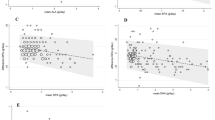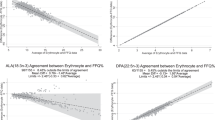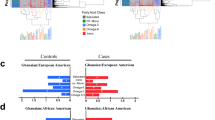Abstract
Background/Objectives:
The objective of this study was to evaluate the ability of a web-based self-administered food frequency questionnaire (web-FFQ) to assess the omega-3 (ω-3) fatty acids (FAs) intake of men affected with prostate cancer (PCa) against a biomarker.
Subjects/Methods:
The study presented herein is a sub-study from a phase II clinical trial. Enrolled patients afflicted with PCa were included in the sub-study analysis if the FA profiles from the red blood cell (RBC) membranes and FA intakes at baseline were both determined at the time of the data analysis (n=60). Spearman’s correlation coefficients were calculated to estimate the correlations between FA intakes and their proportions in the RBC membranes.
Results:
Intakes of eicosapentaenoic acid (EPA) and docosahexaenoic acid (DHA) were highly correlated with their respective proportions in the RBC membranes (both rs=0.593, P<0.0001). Correlation between alpha-linolenic acid (ALA) intake and its proportion in RBC was not significant (rs=0.130, P=0.332). Correlations were observed between fatty fish intake and total ω-3 FAs (rs=0.304, P=0.02), total long-chain ω-3 FAs (rs=0.290, P=0.03) and DHA (rs=0.328, P=0.01) in RBC membranes.
Conclusions:
This study has shown that the web-FFQ is an accurate tool to assess total long-chain ω-3 FAs, EPA and DHA but not ALA intake in clinical trials and epidemiological studies carried out in men with PCa.
This is a preview of subscription content, access via your institution
Access options
Subscribe to this journal
Receive 12 print issues and online access
$259.00 per year
only $21.58 per issue
Buy this article
- Purchase on Springer Link
- Instant access to full article PDF
Prices may be subject to local taxes which are calculated during checkout

Similar content being viewed by others
References
Gerber M . Omega-3 fatty acids and cancers: a systematic update review of epidemiological studies. Br J Nutr 2012; 107 (Suppl 2), S228–S239.
Greenwald P, Clifford CK, Milner JA . Diet and cancer prevention. Eur J Cancer 2001; 37: 948–965.
Subar AF, Dodd KW, Guenther PM, Kipnis V, Midthune D, McDowell M et al. The food propensity questionnaire: concept, development, and validation for use as a covariate in a model to estimate usual food intake. J Am Diet Assoc 2006; 106: 1556–1563.
Hirsch J, Farquhar JW, Ahrens Jr EH, Peterson ML, Stoffel W . Studies of adipose tissue in man. A microtechnic for sampling and analysis. Am J Clin Nutr 1960; 8: 499–511.
Kaaks R, Riboli E, Sinha R . Biochemical markers of dietary intake. IARC Sci Publ 1997; 142: 103–126.
Feunekes GI, Van Staveren WA, De Vries JH, Burema J, Hautvast JG . Relative and biomarker-based validity of a food-frequency questionnaire estimating intake of fats and cholesterol. Am J Clin Nutr 1993; 58: 489–496.
Serra-Majem L, Nissensohn M, Overby NC, Fekete K . Dietary methods and biomarkers of omega 3 fatty acids: a systematic review. Br J Nutr 2012; 107 (Suppl 2), S64–S76.
King IB, Lemaitre RN, Kestin M . Effect of a low-fat diet on fatty acid composition in red cells, plasma phospholipids, and cholesterol esters: investigation of a biomarker of total fat intake. Am J Clin Nutr 2006; 83: 227–236.
Mikkelsen TB, Osler M, Olsen SF . Validity of protein, retinol, folic acid and n-3 fatty acid intakes estimated from the food-frequency questionnaire used in the Danish National Birth Cohort. Public Health Nutr 2006; 9: 771–778.
Wennberg M, Vessby B, Johansson I . Evaluation of relative intake of fatty acids according to the Northern Sweden FFQ with fatty acid levels in erythrocyte membranes as biomarkers. Public Health Nutr 2009; 12: 1477–1484.
Zhang B, Wang P, Chen CG, He QQ, Zhuo SY, Chen YM et al. Validation of an FFQ to estimate the intake of fatty acids using erythrocyte membrane fatty acids and multiple 3d dietary records. Public Health Nutr 2010; 13: 1546–1552.
Sullivan BL, Williams PG, Meyer BJ . Biomarker validation of a long-chain omega-3 polyunsaturated fatty acid food frequency questionnaire. Lipids 2006; 41: 845–850.
Sun Q, Ma J, Campos H, Hankinson SE, Hu FB . Comparison between plasma and erythrocyte fatty acid content as biomarkers of fatty acid intake in US women. Am J Clin Nutr 2007; 86: 74–81.
Mozaffarian D, Wu JH . (n-3) fatty acids and cardiovascular health: are effects of EPA and DHA shared or complementary? J Nutr 2012; 142: 614S–625S.
Larsson SC, Kumlin M, Ingelman-Sundberg M, Wolk A . Dietary long-chain n-3 fatty acids for the prevention of cancer: a review of potential mechanisms. Am J Clin Nutr 2004; 79: 935–945.
Serhan CN . Pro-resolving lipid mediators are leads for resolution physiology. Nature 2014; 510: 92–101.
Wendel M, Heller AR . Anticancer actions of omega-3 fatty acids—current state and future perspectives. Anticancer Agents Med Chem 2009; 9: 457–470.
Dennis LK, Snetselaar LG, Smith BJ, Stewart RE, Robbins ME . Problems with the assessment of dietary fat in prostate cancer studies. Am J Epidemiol 2004; 160: 436–444.
Roehrborn CG, Boyle P, Nickel JC, Hoefner K, Andriole G, Aria A et al. Efficacy and safety of a dual inhibitor of 5-alpha-reductase types 1 and 2 (dutasteride) in men with benign prostatic hyperplasia. Urology 2002; 60: 434–441.
Labonte ME, Cyr A, Baril-Gravel L, Royer MM, Lamarche B . Validity and reproducibility of a web-based, self-administered food frequency questionnaire. Eur J Clin Nutr 2012; 66: 166–173.
Subar AF . Developing dietary assessment tools. J Am Diet Assoc 2004; 104: 769–770.
Debruyne F, Barkin J, van Erps P, Reis M, Tammela TL, Roehrborn C . Efficacy and safety of long-term treatment with the dual 5 alpha-reductase inhibitor dutasteride in men with symptomatic benign prostatic hyperplasia. Eur Urol 2004; 46: 488–494. discussion 95.
Roehrborn CG, Siami P, Barkin J, Damiao R, Major-Walker K, Nandy I et al. The effects of combination therapy with dutasteride and tamsulosin on clinical outcomes in men with symptomatic benign prostatic hyperplasia: 4-year results from the CombAT study. Eur Urol 2010; 57: 123–131.
Fleshner NE, Lucia MS, Egerdie B, Aaron L, Eure G, Nandy I et al. Dutasteride in localised prostate cancer management: the REDEEM randomised, double-blind, placebo-controlled trial. Lancet 2012; 379: 1103–1111.
Payton S . Prostate cancer: third time lucky? Dutasteride for tertiary prevention of prostate cancer. Nat Rev Urol 2013; 10: 63.
Lohman TG, Roche AF, Martorell R. . Anthropometric Standardization Reference Manual. Human Kinetics Books: Champaign, Illinois 1988.
Schakel SF, Sievert YA, Buzzard IM . Sources of data for developing and maintaining a nutrient database. J Am Diet Assoc 1988; 88: 1268–1271.
Canada S, Canadian Nutrient File 2007 [cited 2007]. Available at www.healthcanada.gc.ca/cnf.
Rudkowska I, Paradis AM, Thifault E, Julien P, Tchernof A, Couture P et al. Transcriptomic and metabolomic signatures of an n-3 polyunsaturated fatty acids supplementation in a normolipidemic/normocholesterolemic Caucasian population. J Nutr Biochem 2013; 24: 54–61.
Shaikh NA, Downar E . Time course of changes in porcine myocardial phospholipid levels during ischemia. A reassessment of the lysolipid hypothesis. Circ Res 1981; 49: 316–325.
Lepage G, Roy CC . Direct transesterification of all classes of lipids in a one-step reaction. J Lipid Res 1986; 27: 114–120.
Counil E, Julien P, Lamarche B, Chateau-Degat ML, Ferland A, Dewailly E . Association between trans-fatty acids in erythrocytes and pro-atherogenic lipid profiles among Canadian Inuit of Nunavik: possible influences of sex and age. Br J Nutr 2009; 102: 766–776.
Willett W . Nutritional Epidemiology, 2nd edn. Oxford University Press: USA, 1998.
Andersen LF, Solvoll K, Drevon CA . Very-long-chain n-3 fatty acids as biomarkers for intake of fish and n-3 fatty acid concentrates. Am J Clin Nutr 1996; 64: 305–311.
Pawlosky RJ, Hibbeln JR, Novotny JA, Salem N Jr . Physiological compartmental analysis of alpha-linolenic acid metabolism in adult humans. J Lipid Res 2001; 42: 1257–1265.
Arterburn LM, Hall EB, Oken H . Distribution, interconversion, and dose response of n-3 fatty acids in humans. Am J Clin Nutr 2006; 83 (6 Suppl), 1467S–1476S.
Orton HD, Szabo NJ, Clare-Salzler M, Norris JM . Comparison between omega-3 and omega-6 polyunsaturated fatty acid intakes as assessed by a food frequency questionnaire and erythrocyte membrane fatty acid composition in young children. Eur J Clin Nutr 2008; 62: 733–738.
Schaeffer L, Gohlke H, Muller M, Heid IM, Palmer LJ, Kompauer I et al. Common genetic variants of the FADS1 FADS2 gene cluster and their reconstructed haplotypes are associated with the fatty acid composition in phospholipids. Hum Mol Genet 2006; 15: 1745–1756.
Arab L . Biomarkers of fat and fatty acid intake. J Nutr 2003; 133 (Suppl 3), 925S–932S.
Arab L, Akbar J . Biomarkers and the measurement of fatty acids. Public Health Nutr 2002; 5: 865–871.
Ansorena D, Guembe A, Mendizabal T, Astiasaran I . Effect of fish and oil nature on frying process and nutritional product quality. J Food Sci 2010; 75: H62–H67.
Godley PA, Campbell MK, Miller C, Gallagher P, Martinson FE, Mohler JL et al. Correlation between biomarkers of omega-3 fatty acid consumption and questionnaire data in African American and Caucasian United States males with and without prostatic carcinoma. Cancer Epidemiol Biomarkers Prev 1996; 5: 115–119.
Acknowledgements
We are grateful to all patients who participated in this study. This research was funded by Prostate Cancer Canada (clinician scientist award) and the American Urological Association (young investigator grant) awarded to VF, and also Fonds de Recherche du Québec en Santé, Junior 1 career award to support this work. JA is a recipient of scholarships for undergraduate students from the Natural Sciences and Engineering Research Council of Canada. M-EL is a recipient of doctoral scholarships from the Canadian Institutes of Health Research and the Fonds de recherche du Québec—Santé. BL is Chair in Nutrition and Cardiovascular Health at the Department of Food Sciences and Nutrition, Laval University. PJ is director of the Endocrinology and Nephrology Axis at the CHU de Québec Research Center, Laval University. We thank Hélène Hovington and Claire Ménard for the management of database and collection of biological specimens. Finally, we thank Line Berthiaume and Karine Greffard for the analyses of fatty acid profiles of biological specimens.
Author information
Authors and Affiliations
Corresponding author
Ethics declarations
Competing interests
The authors declare no conflict of interest.
Additional information
Supplementary Information accompanies this paper on European Journal of Clinical Nutrition website
Rights and permissions
About this article
Cite this article
Allaire, J., Moreel, X., Labonté, MÈ. et al. Validation of the omega-3 fatty acid intake measured by a web-based food frequency questionnaire against omega-3 fatty acids in red blood cells in men with prostate cancer. Eur J Clin Nutr 69, 1004–1008 (2015). https://doi.org/10.1038/ejcn.2015.7
Received:
Revised:
Accepted:
Published:
Issue Date:
DOI: https://doi.org/10.1038/ejcn.2015.7
This article is cited by
-
Are dietary intake and nutritional status of specific polyunsaturated fatty acids correlated with sarcopenia outcomes in community-dwelling older adults with sarcopenia? – Exploratory results from ENHANce
BMC Geriatrics (2023)
-
Relationship between dietary intake and erythrocyte PUFA in adolescents from a Western Australian cohort
European Journal of Clinical Nutrition (2023)
-
Effects of concentrated long-chain omega-3 polyunsaturated fatty acid supplementation before radical prostatectomy on prostate cancer proliferation, inflammation, and quality of life: study protocol for a phase IIb, randomized, double-blind, placebo-controlled trial
BMC Cancer (2018)
-
Comparison of fatty acid intakes assessed by a cardiovascular-specific food frequency questionnaire with red blood cell membrane fatty acids in hyperlipidaemic Australian adults: a validation study
European Journal of Clinical Nutrition (2016)



